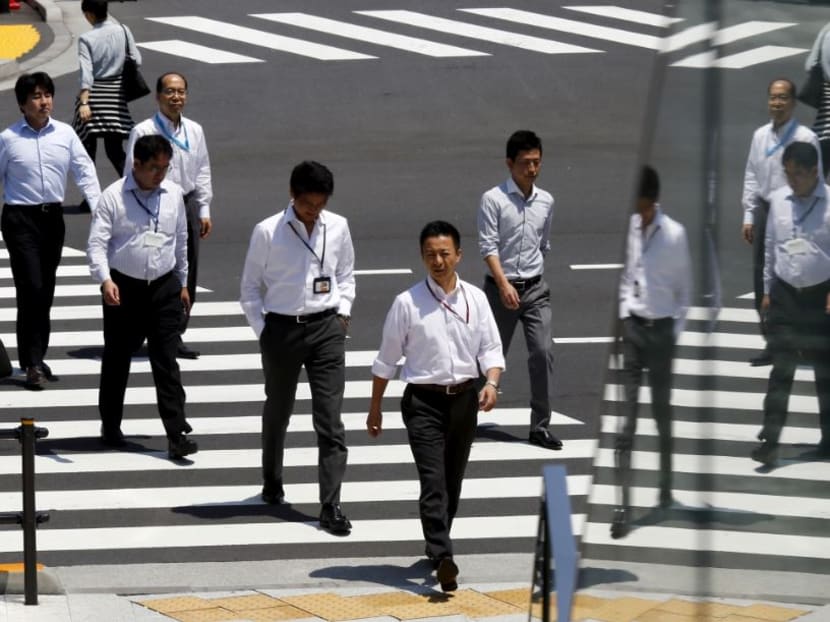In Japan, pay rises go towards supporting the elderly
TOKYO — Ms Yuko Shimomura was delighted to get a small pay rise this year, but her happiness quickly turned to frustration when the first payslip arrived. "My health insurance, care insurance and pension contributions are going up faster so I hardly see any actual increase in my paycheck,” she said, reflecting a predicament shared by millions of salaried workers across Japan who find that even though their pay is rising, the gains are swallowed by a range of compulsory payments ultimately used to support the country’s ageing population.

TOKYO — Ms Yuko Shimomura was delighted to get a small pay rise this year, but her happiness quickly turned to frustration when the first payslip arrived.
“My wages are only going up a little bit,” said Ms Shimomura, who works for an insurance company in Tokyo.
“But my health insurance, care insurance and pension contributions are going up faster so I hardly see any actual increase in my paycheck.”
Ms Shimomura’s predicament is shared by millions of salaried workers across Japan who find that even though their pay is rising, the gains are swallowed by a range of compulsory payments ultimately used to support the country’s ageing population.
Monthly premiums for care insurance have doubled from ¥3,000 (S$36.70) to almost ¥6,000 since the system began in 2000.
Meanwhile, the average annual cost of employer-based health insurance is up from ¥386,038 in 2008 to ¥486,042 this year, equivalent to a two percentage point rise in income tax.
The rise in health and care costs helps to explain why moderate wage growth, after five years of economic stimulus under Prime Minister Shinzo Abe, is doing so little to boost consumption.
It poses a conundrum for the Bank of Japan, which is relying on spending pressure to push inflation towards its 2 per cent objective.
“The number of old people is just going to go up, so to support them the system will need more money,” said Mr Hiroko Ogiwara, a financial commentator.
With the national budget under pressure, the government is likely to pass more of the burden on to individuals, she said.
According to the interior ministry’s household survey, the cumulative gain in average monthly incomes for working households from 2010 to 2017 is ¥13,128, while the cumulative rise in direct taxes and social insurance contributions is ¥9,386.
Add in the 2014 rise in consumption tax from 5 to 8 per cent and it is no surprise that households do not feel much better off.
Japan’s social care system illustrates what is going on.
In 2000, the country brought in a national funding scheme to ensure equal access to care. When care is needed the system pays 90 per cent of the cost, or 80 per cent for those with higher incomes.
One quarter of the funding comes from national taxation, a quarter from local taxation, 28 per cent from contributions by workers aged 40-64 and the rest from contributions by pensioners.
The required contributions rise automatically as more people need care.
Health insurance, for which most salaried workers pay premiums to a health association through their employer, has also been increasing.
A 2008 reform required those associations to contribute much more to a national healthcare scheme for the over-75s. As a result, the premiums paid by workers have risen sharply.
The burden of paying for over-75s is putting the whole employer-based system under strain.
“We understand the need [to pay for the elderly] but there’s a limit and perhaps we have exceeded that limit,” said Mr Keita Tagawa, a senior executive at Kenporen, the federation of health insurance associations.
Income transferred to the elderly in this way does get spent. But rather than meals out, cars and holidays it goes on medical procedures and social care, which are bought at strictly regulated prices, and rationed by the available budget.
As a result, the extra demand does less to push up inflation.
Japan’s future holds more of the same, especially after 2020, when the baby boom generation starts to reach the age of 75 and needs more care.
Recent government figures suggest that by 2040 social insurance costs will rise another 2.5 percentage points to 24 per cent of gross domestic product.
For Ms Shimomura, that means the strong growth under Mr Abe does little for her standard of living. “Things haven’t got better for me,” she said.
“I can see overall business conditions have got better, but for lots of people there’s really nothing to make you want to spend more.” FINANCIAL TIMES






